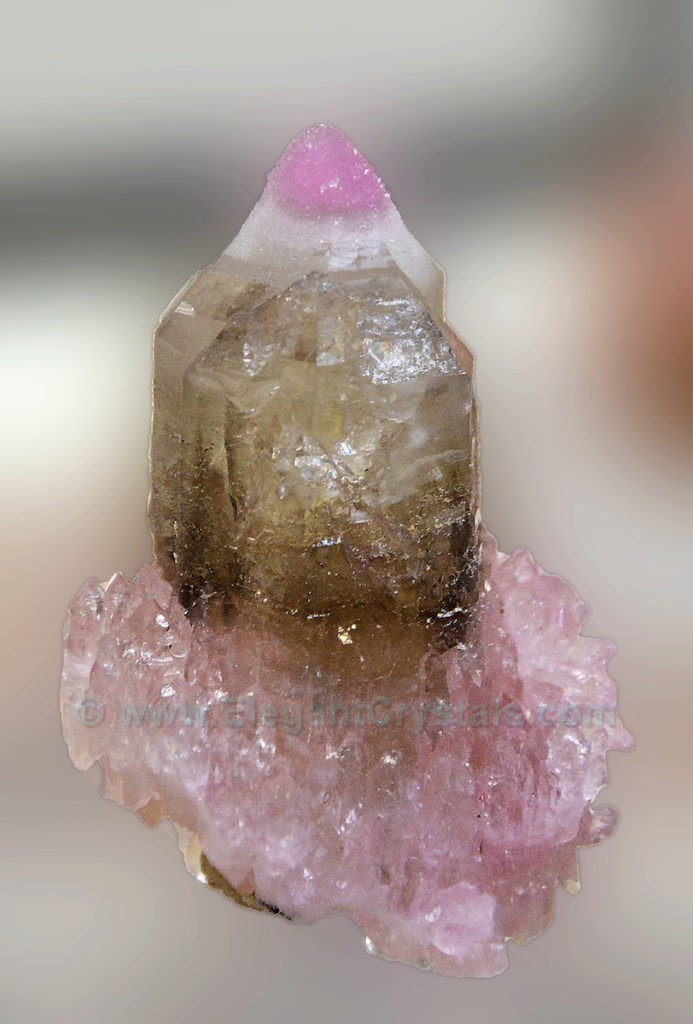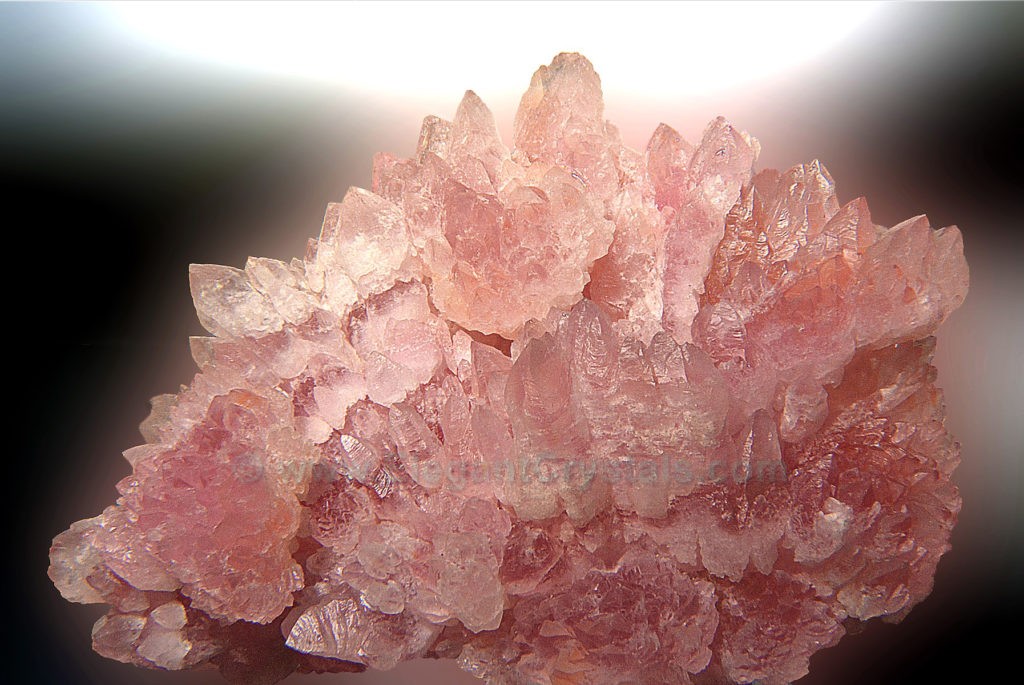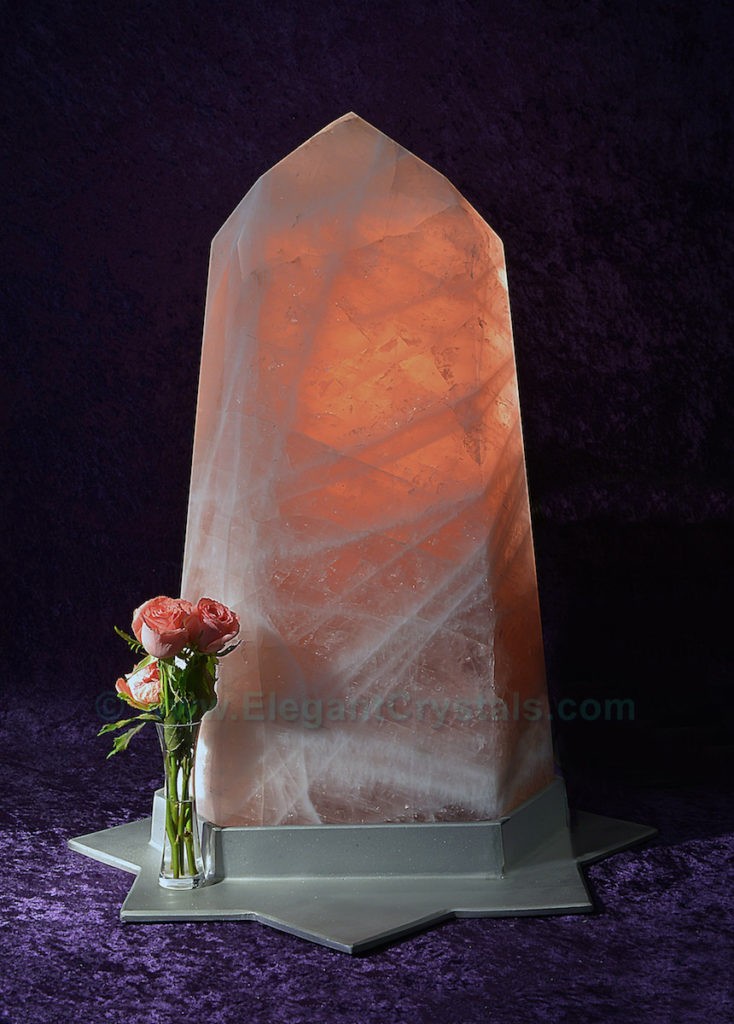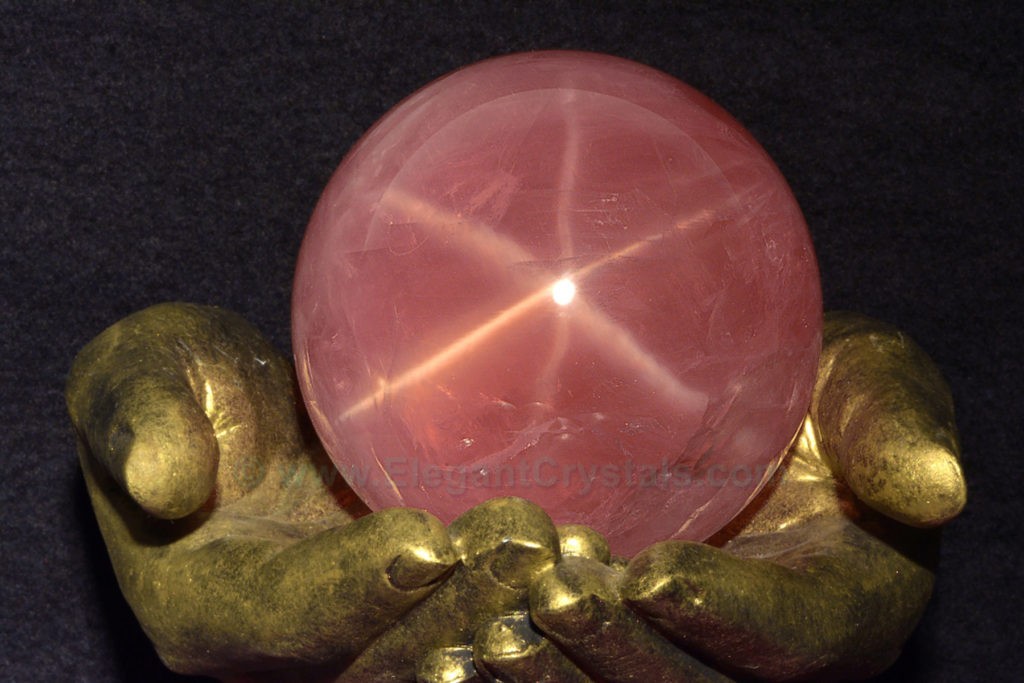CHAPTER 14
ROSE QUARTZ

Picture #92
1.5-inch-tall Brazilian Rose and Smoky Quartz Castle
Courtesy of Carolyn Manchester
This is the most perfect rose-skirted castle I have ever seen.
This 1.5-inch specimen contains dozens of parallel pink points.
This type of formation is seldom found anywhere in the world other than Brazil.
Individual rose quartz crystals rarely exceed one-inch in length.
If you find a large rose quartz crystal in a store or gallery, chances are it was sculpted from a rose quartz boulder.
Because the natural rose quartz crystals are so small and rare, creative lapidary artists will carve and polish rose quartz chunks or boulders
into all kinds of shapes and sizes of pink sculpture, even simulating natural six-sided crystal shapes.
Typically, that kind of opaque rose quartz has zones or streaks of pure white quartz within the pink.

Picture #93
Three-inch-wide Rose Quartz Cluster
You probably cannot tell from this photo, but this little cluster is only 3 inches wide.
The pink color in rose quartz comes from titanium atoms dispersed in the atomic matrix.
Recently, researchers discovered parallel bundles of minute pink crystals within rose quartz.
When they microscopically examined these needle-like bundles, they discovered that the tiny tubes only emitted pink colors from the ends of the fibers.
The sides of these thin crystals were clear and color free.
This is called the dichroic effect (two colors.)
When light bounced off the sides of the microscopic fibers, it created a halo of blue light around the clear and pink zones (the Tyndall effect.)

Picture #94
55-pound Polished Rose Quartz Generator in Stainless Steel Stand
This 55-pound rose quartz crystal was carved out of a much larger boulder.
This is a typical example of how rough material can be carved and polished into exquisite shapes of vividly colored stones.
Even though the carving mimics a natural quartz crystal shape, it is a sculptural form of rose quartz.
I really like the way that the light bulb behind the crystal shines through and creates additional warm colors inside the translucent rose quartz.
This generator crystal was cut in a tabular shape.
It is fairly thin compared to the width and height.
Because the crystal is thin, light is transmitted even more beautifully through the stone.

Picture #95
Four-inch-diameter Rose Quartz Ball Exhibiting Asterism
We have briefly examined the origins of rose quartz colors in crystals.
The microscopic tubules that create the color sometimes grow large enough to reflect light in strange and beautiful patterns.
These micro-crystals are related to rutile (rutilated quartz.)
When many micro-crystals line up in rows, you see the effect as a “star stone.”
Have you heard the terms “star ruby” or “star sapphire?”
The star effect is found in many kinds of gem-quality minerals covering an entire rainbow of colors.
These beautiful stars tones are a rare and valuable phenomenon.
The star effect is called “asterism” or “asterated gems.”
The crystal ball shown above came from Madagascar and is only four inches wide.
It shows a perfect six-rayed star in slightly golden light on one end.
Each of the rays of the star wraps around the sphere to form a second star at the exact opposite point.
The rays of the star have different levels of brightness.
You can see this as wider or narrower color bands.
This optical effect can project above the surface of the ball as the star eerily floats in the air. On a large star rose ball, you can put your fingertip underneath the arc of the golden ray of light.
It will look like the light is floating above your finger.
The crystal is projecting light as a holographic image.

Picture #96
2-inch-wide Brazil Clear Rose Quartz with Asterism
Here is a tiny star rose quartz ball.
This two-inch gem has amazing clarity for rose crystal.
Now you can see a complex structure that shows three different color effects at one time.
I lit up this ball with a fiber optic light source.
All the light that you see is coming directly through the ball itself.
There is a hint of rose quartz from microscopic pink fibers as well as blue light scattering off the sides of the clear micro-crystals.
This is called the Tyndall effect.
That’s also why the sky appears blue.
In air, light rays are re-emitted from oxygen and create a color shift towards the blue end of the spectrum.
In quartz, light rays interact with the oxygen in the silica structure to give the illusion of blue color.
Notice how the blue and pink colors are distinct yet seem to blend in the same space.
The crystal ball also concentrates and amplifies light around the perimeter as a bright ring of orange and yellow light encircling the globe.
Underneath the ball, a stack of Plexiglas squares forms a mysterious pyramid that I had to illuminate separately.
Inside this nearly clear ball, there are a few small pressure cracks called “fissures.”
These small shiny gaps in the crystal structure reflect and amplify light to form little bright zones.

Picture #97
Carved Rose Quartz Hearts from Madagascar
with Star/Asterism Patterns
Asterism stars can only be seen on curved surfaces- spheres, eggs, hearts, and cabochon-cut stones.
Each star will have its opposite star on the far side of a curved stone.
The stars at the “poles” of a sphere will be connected by 6 lines of light.
If the stone is cut flat or curved in such a way that you can only see one ray of light instead of the six-rayed star, the gem stone is called “cat’s eye” or “chatoyant”, French for cat’s eye.
Cat’s-eye effects are a type of asterism where the entire star cannot be seen because of the way the stone was cut.
Back in 1985, I purchased a one-inch long clear quartz, double cabochon with large curves on both the front and back.
Inside of this slightly hazy stone, I found seven stars with six rays each!
As I turned the stone around, the stars would light up one-by-one and flash in my eyes.
A friend showed me how to take a double cabochon with stars and spin it in a clean small bowl.
As it rotated, I could see a succession of twinkling stars moving around the perimeter of the disc.
It looked like a miniature UFO twinkling in the night sky.
